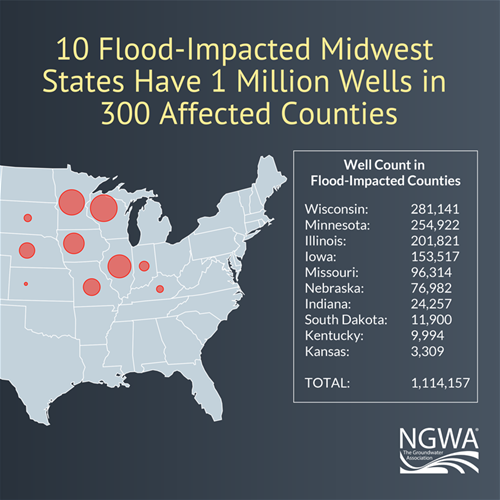Exposure to E. Coli and Coliform Possible in Flooded Locations
(WESTERVILLE, OH — March 25, 2019) —The National Ground Water Association (NGWA), drawing on federal and state weather and emergency information, estimates that more than 300 counties in the Midwest have wells potentially impacted by late winter flooding. While the exact number of wells possibly affected by contaminated floodwater cannot be readily counted, Census Bureau data show over one million wells in these counties. This well estimate includes counties flooded in Illinois, Indiana, Iowa, Kansas, Kentucky, Minnesota, Missouri, Nebraska, South Dakota, and Wisconsin during the March 2019 winter storm.

The Association says the number of wells potentially impacted could be substantial because a large portion of the Midwest affected relies on groundwater for rural and small municipal water supply. Household, farm, and small business wells situated in broad, sand and gravel valleys and glaciated rolling countryside could be standing in water for several days, raising the potential for contamination if the wells aren’t properly maintained. Exposure to E. coli, coliform, and other pathogenic microbes from human and animal fecal matter in floodwaters is a common health concern following a major flooding event. Floodwater can also carry other contaminants.
“Although the ground is frozen in March in most of this vast, productive agricultural region, wells can still be vulnerable,” said Chuck Job, NGWA regulatory affairs manager who compiled this data. “Even slight flooding around a well can potentially carry contaminated water to the wellhead, and if the wellhead is cracked or faulty in any way, the well and water system could be compromised.”
Dr. Bill Alley, NGWA science director, also notes as temperatures rise, well owners should continue to monitor and test their systems.
“While frozen ground may not be saturated from storm water, warmer weather may allow flood waters to infiltrate and contaminate subsurface water during a thaw,” Alley said.
By comparison, NGWA estimated more than 730,000 wells were potentially affected by the Atlantic hurricane season in North Carolina, Georgia, South Carolina, Florida, Virginia, and Alabama.
Following a flood, disinfection and wellhead repair may be common needs among well owners. Well relocation and elevation may also be useful and protective. As always, NGWA recommends water well system professionals be used to assess and service wells.
NGWA has a flooding resource center on its website. Included is information on how to protect well systems before and after a flooding event.
NGWA also has other resources contractors may find helpful in dealing with flooded water wells including the best suggested practice Residential Water Well Disinfection Following a Flood Event: Procedures for Water Well System Professionals and a Water Well Journal® article titled “Responding to Flooded Wells” at WellOwner.org/hurricane-resources.
*1990 US Census Bureau Survey of Population and Housing (including wells – last census of wells in all counties)
National Weather Service, Hazardous Weather Outlook (for individual states and regions), and State Emergency Management Information on state websites.
______________________________________________________________________
The National Ground Water Association is a not-for-profit professional society and trade association for the global groundwater industry. Our members around the world include leading public and private sector groundwater scientists, engineers, water well system professionals, manufacturers, and suppliers of groundwater-related products and services. The Association’s vision is to be the leading groundwater association advocating for responsible development, management, and use of water.